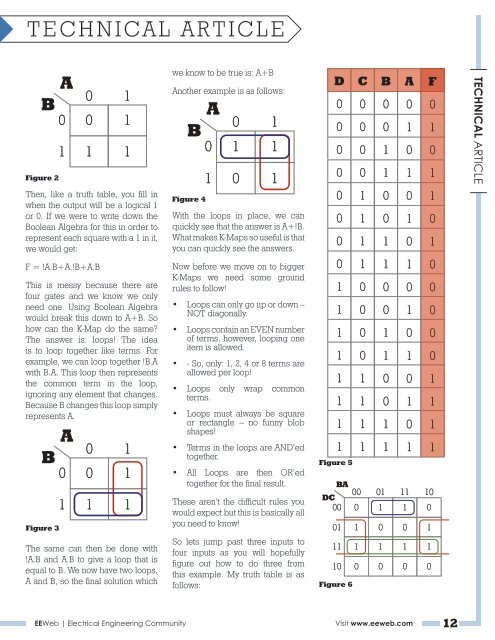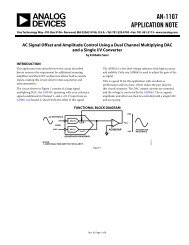Russ Croman - EEWeb
Russ Croman - EEWeb
Russ Croman - EEWeb
Create successful ePaper yourself
Turn your PDF publications into a flip-book with our unique Google optimized e-Paper software.
TECHNICAL ARTICLE<br />
B<br />
Figure 2<br />
A<br />
0<br />
0 1<br />
0 1<br />
1 1 1<br />
Then, like a truth table, you fill in<br />
when the output will be a logical 1<br />
or 0. If we were to write down the<br />
Boolean Algebra for this in order to<br />
represent each square with a 1 in it,<br />
we would get:<br />
F = !A.B+A.!B+A.B<br />
This is messy because there are<br />
four gates and we know we only<br />
need one. Using Boolean Algebra<br />
would break this down to A+B. So<br />
how can the K-Map do the same?<br />
The answer is: loops! The idea<br />
is to loop together like terms. For<br />
example, we can loop together !B.A<br />
with B.A. This loop then represents<br />
the common term in the loop,<br />
ignoring any element that changes.<br />
Because B changes this loop simply<br />
represents A.<br />
B<br />
Figure 3<br />
A<br />
0<br />
0 1<br />
0 1<br />
1 1 1<br />
The same can then be done with<br />
!A.B and A.B to give a loop that is<br />
equal to B. We now have two loops,<br />
A and B, so the final solution which<br />
we know to be true is: A+B<br />
Another example is as follows:<br />
B<br />
Figure 4<br />
A<br />
0<br />
0 1<br />
1 1<br />
1 0 1<br />
With the loops in place, we can<br />
quickly see that the answer is A+!B.<br />
What makes K-Maps so useful is that<br />
you can quickly see the answers.<br />
Now before we move on to bigger<br />
K-Maps we need some ground<br />
rules to follow!<br />
• Loops can only go up or down –<br />
NOT diagonally.<br />
• Loops contain an EVEN number<br />
of terms, however, looping one<br />
item is allowed.<br />
• - So, only: 1, 2, 4 or 8 terms are<br />
allowed per loop!<br />
• Loops only wrap common<br />
terms.<br />
• Loops must always be square<br />
or rectangle – no funny blob<br />
shapes!<br />
• Terms in the loops are AND’ed<br />
together.<br />
• All Loops are then OR’ed<br />
together for the final result.<br />
These aren’t the difficult rules you<br />
would expect but this is basically all<br />
you need to know!<br />
So lets jump past three inputs to<br />
four inputs as you will hopefully<br />
figure out how to do three from<br />
this example. My truth table is as<br />
follows:<br />
Figure 6<br />
<strong>EEWeb</strong> | Electrical Engineering Community Visit www.eeweb.com 12<br />
D<br />
0<br />
0<br />
0<br />
0<br />
0<br />
0<br />
0<br />
0<br />
1<br />
1<br />
1<br />
1<br />
1<br />
1<br />
1<br />
1<br />
Figure 5<br />
C<br />
0<br />
0<br />
0<br />
0<br />
1<br />
1<br />
1<br />
1<br />
0<br />
0<br />
0<br />
0<br />
1<br />
1<br />
1<br />
1<br />
B<br />
0<br />
0<br />
1<br />
1<br />
0<br />
0<br />
1<br />
1<br />
0<br />
0<br />
1<br />
1<br />
0<br />
0<br />
1<br />
1<br />
BA<br />
00<br />
DC<br />
01<br />
00 0 1<br />
01<br />
11<br />
10<br />
1<br />
0<br />
1 1<br />
0 0<br />
A<br />
0<br />
1<br />
0<br />
1<br />
0<br />
1<br />
0<br />
1<br />
0<br />
1<br />
0<br />
1<br />
0<br />
1<br />
0<br />
1<br />
F<br />
0<br />
1<br />
0<br />
1<br />
1<br />
0<br />
1<br />
0<br />
0<br />
0<br />
0<br />
0<br />
1<br />
1<br />
1<br />
1<br />
11 10<br />
1 0<br />
0 1<br />
1 1<br />
0 0<br />
TECHNICAL ARTICLE















